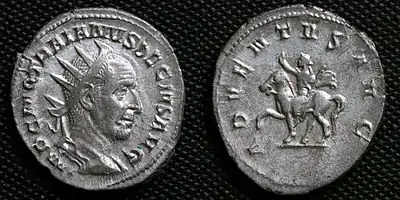Adventus (ceremony)
The adventus was a ceremony in ancient Rome, in which an emperor was formally welcomed into a city[1] either during a progress or after a military campaign, often (but not always) Rome. The term is also used to refer to artistic depictions (usually in relief sculpture, including coins) of such ceremonies.[2] Its 'opposite' is the profectio.[3]
 | |
| O: draped and cuirassed bust with radiate crown of Trajan Decius
IMP C M Q TRAIANVS DECIVS AVG |
R: Trajan Decius riding horse, raising hand and holding scepter
ADVENTVS AVG |
| silver antoninianus struck in Rome 250 AD; ref.: RIC 11b; RSC 4
This coin was struck to the occasion of emperor's return (adventus) to Rome. | |
For comparable ceremonies in Medieval and Early Modern Europe, sometimes employing consciously 'Roman' iconology, see Royal entry.
References
- The Inheritance of Rome, Chris Wickham, Penguin Books Ltd. 2009, ISBN 978-0-670-02098-0. p. 67.
- Sabine MacCormack (1974). Adventus and Consecratio: Studies in Roman Imperial Art and Panegyric from the Late Third to the Sixth Century. University of Oxford.
- Björn C. Ewald; Carlos F. Noreña (2 December 2010). The Emperor and Rome: Space, Representation, and Ritual. Cambridge University Press. pp. 40–. ISBN 978-0-521-51953-3.
This article is issued from Wikipedia. The text is licensed under Creative Commons - Attribution - Sharealike. Additional terms may apply for the media files.